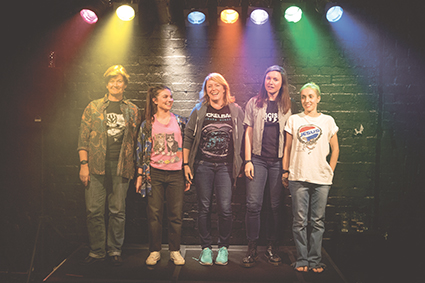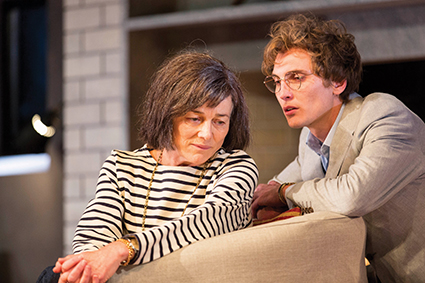Bigger than average performance anxieties
Keith Gallasch: Cyrano De Bergerac, Is This Thing On?, Switzerland

Yalin Ozucelik, Richard Roxburgh in Sydney Theatre Company’s production of Cyrano de Bergerac
photo © Brett Boardman 2014
Yalin Ozucelik, Richard Roxburgh in Sydney Theatre Company’s production of Cyrano de Bergerac
IN ONE WAY OR ANOTHER, THREE PRODUCTIONS IN SYDNEY IN RECENT WEEKS—TWO OF THEM OF NEW AUSTRALIAN PLAYS BY WOMEN ABOUT WOMEN AND ONE A CLASSIC BY A MALE ABOUT A MALE—SHARED A REVEALING FOCUS ON PERFORMANCE. CYRANO DE BERGERAC, A FEMALE STAND-UP COMEDIAN AND A FAMOUS NOVELIST, PATRICIA HIGHSMITH, ALL BECOME EMOTIONALLY UNSTUCK WHILE ATTEMPTING TO SUSTAIN PERSONAE THAT MASK VULNERABILITIES.
STC, Cyrano de Bergerac
A man of enormous pride and charisma, a popular poet and accomplished swordsman, Cyrano de Bergerac nonetheless dooms himself to misery in the belief that he is unloveably ugly. Richard Roxburgh as Cyrano delivers the requisite crowd-pleasing bravado with panache and deals his enemies just the right degree of cruelty, verbal and physical. But, deftly and incisively, Roxburgh reveals the cracks early on—a palpable fragility, sentences that come unstuck when Cyrano’s not on show—preparing us for a darker, less melodramatic demise than usually anticipated: a tragedy imbued with a touch of the manic depressive.
Eryn Jean Norvill’s Roxane appearing at first a delicate flower is soon shown to be intelligent, forthright and physically robust—an ideal partner for Cyrano, if only… Chris Ryan’s Christian is a charming innocent, played with a kind of engaging Ocker ease. Josh McConville’s Guiche is convincingly both scary and comic. The mobile 17th century stage within the Sydney Theatre’s large open space presents numerous opportunities for lively staging and amplifies the sense of performance that is Cyrano’s outer world; the inner one he cannot enact. Sharp-eyed, witty direction and economic adaptation (Andrew Upton), fine period design (Alice Babbage), an immersive sound world (Paul Charlier), characterful casting and a superb Roxburgh all made for a seriously memorable Cyrano de Bergerac.

Cast: Fiona Press, Madeleine Benson, Susan Prior, Nat Randall, Genevieve Guiffre, Is this thing on?, Belvoir Downstairs
photo Brett Boardman
Cast: Fiona Press, Madeleine Benson, Susan Prior, Nat Randall, Genevieve Guiffre, Is this thing on?, Belvoir Downstairs
Belvoir, Is This Thing On?
The very title of Zoe Coombs Marr’s Is this Thing On?, a riotous depiction of the life of a female stand-up comedian, Brianna—played by five actors across her life—is telling. If the mike is not on, what next? Or what if you stand before it and you can’t speak—that’s the very first and very young Brianna (Madelaine Benson) we see. The stage is then seized by an MC (Susan Prior) who treats us as comedy club innocents, spitting out bad jokes, letting us know she also works the bar, gossiping about fellow comedians.
The script loops back to a younger Brianna, Genevieve Giuffre, finding her way in stand-up, studying veterinary science, and then another, Nat Randall, more confident, dropping out of university, coming out and unleashing a string of crudely funny, discomfiting fisting jokes. An older Brianna (Fiona Press), back in the business after a breakdown, is relaxed, cynical, the jokes grosser, still working the bar, prone to anger, violence even against a male comedian friend who left her show stranded.
It’s Susan Prior’s Brianna who cracks—she’s unstoppably frantic, barely leaving space for laughs in case there’s silence, bullying her audience, relentlessly on the move, no longer able to veil the anxieties breaking through an already unstable comic persona. It’s an unnerving performance, loud and rarely funny in a conventional sense.
Zoe Coombs Marr writes in her program note, “Since we first met, comedy has been like a charismatic but occasionally abusive lover that I haven’t quite been able to turn away from.” A member of post and a solo performer, Coombs Marr started out in stand-up when she was 15. Is This Thing On? is a grimly articulate account of engaging with your craft, its limits, dangers and a little of the joy of connecting with your audience, and it achieves this by doing it—making us witness how stand-up does and does not work and the pressures that build behind confident facades. There’s little detail in the show about life beyond stand-up, like family or love—save the charismatic abuser mentioned above, comedy itself—but fragile self-love and the courage to perform to make an audience love you, these are revealingly and depressingly on display.

Sarah Peirse and Eamon Farren in Sydney Theatre Company’s production of Switzerland
photo © Brett Boardman
Sarah Peirse and Eamon Farren in Sydney Theatre Company’s production of Switzerland
STC, Switzerland
Actors and stand-up comedians are public performers, writers are deemed private if increasingly having to front their audiences at writers’ weeks and in the media to ensure book sales. The great American crime writer Patricia Highsmith, self-exiled to France and then Switzerland after having felt underappreciated at home and finding herself much admired in Europe, did her fair share of interviews, but not always agreeably. She was even less amicable socially as she grew older and irascible in private. For all her many friends, numerous female lovers and several sustained if fragile relationships, Highsmith seems to have been a loner of a kind with her racial prejudices and fetishes, including a love of snails, fascinated as she was with their sex lives, keeping them in a pocket or leaving them about her house. The oddities of her Texan upbringing, the eternal tensions between herself and her mother, her New York youth and early career (as a well-paid comic book writer during world War II), a promiscuous life in the lesbian community and the failure to break through into the pages of The New Yorker, all combined to create a distinctive personality, bristling with contradictions (Jewish good friends, flirtations with men) which yielded an acute alertness to moral ambiguity with insights into double lives, jealousy and criminal desire—principally realised in the form of her male characters.
Joanna Murray-Smith conjures up Highsmith’s final days in a Swiss mountain ‘bunker,’ alone, bitter and alcoholic, dealing with a young publisher’s representative determined to coax her into writing another Ripley novel. The previous envoy suffered a breakdown, believing that Highsmith had threatened him in his bed with a knife. The new arrival appears to be destined for the same, or worse (he wakes with a nick on his neck). For all his naivety—he can’t handle Highsmith’s caustic wit and relentless abuse—he is oddly determined, eventually finding his way to break through, largely through discovering a shared blokey interest in guns and then urging the writer to improvise the opening scenario for a new Ripley novel, which she does, but imposing on him the responsibility of deciding how the murder is committed—a decision she will regret since it will play some part in the young man’s transformation—a very Highsmith one.
Switzerland is an entertaining and suspenseful two-hander. Sarah Pierse is an ideal casting choice as Patricia, not only having something of the look of Highsmith about her, but with her slight drawl, her staggered walk and a pained stoop she conveys both old age and something predatory. It’s a shock when, alone, she dances falteringly to a beloved show tune (one of the real Highsmith’s pleasures). Eamon Farren’s young man, Edward, has the indeterminant demeanour of a Ripley, his persona mutating across the play’s three acts—innocent, then manipulatively probing and then… Like Ripley, he’s a performer. In Act One we believe him, his American clichés failing to cut though Patricia’s well-established obstinacies and prejudices. In Act Two, he’s a touch smarter, doubt creeps in.
The three-act structure is not perfect. Act Two, instead of following up on the cut the young man finds on his neck in the morning and entwining it suspensefully with what follows, moves rather expositionally on to everything we need to know about Highsmith, with a consequent slackening of pace and suspense if interesting in itself (her obsessions, paranoias, her objections to America etc) and providing some fuel for the young man’s machinations (guns, vulnerabilities). Act Three begins strikingly, some of the audience laughing with surprise at something as simple and so telling, plot-wise, as a costume change.
If you buy the conceit that Highsmith finds herself trapped in a plot very much like the ones she wrote, then you’ll be satisfied with Switzerland, but you wouldn’t want to think about it too much. A long-term Highsmith fan, I greatly enjoyed Switzerland, despite Act Two’s slackening and Act Three’s less than inventive ending; the performances are engrossing and there are moments when Murray Smith captures Highsmith’s creepily crystalline way of describing the world and her capacity to throw us into moral confusion.
Unfortunately, the inner-dramaturg on automatic, I thought too much about Switzerland and had to ask some difficult questions. Is Patricia Highsmith, who has told us so much about criminal minds and readers’ perverse desires (for Ripley to ‘get away with it,’ or “the complete corruption of the reader,” as Patricia puts it) and who was cruel but never herself a criminal, due the punishment Murray Smith deals her? What kind of wish fulfilment is going on here? Secondly, why run with the obvious Highsmith formula—why not replace Edward with a young woman who might re-ignite a spark of sexual desire in the dying Patricia and make more pivotal and more ambiguous the “You excite me!” passage in Act Three.
Highsmith kept her writing about women discrete from her crime writing in the non-crime novels and in Carol, her ‘lesbian’ novel, but here’s an opportunity to bring the two worlds together that co-habited the writer’s psyche. When Patricia, who obstinately lives in the past, asks Edward to speak to her of New York diners and the young women who lunch there, he informs her that there are very few diners anymore—and that young women have changed “Don’t do that!,” she snaps, upset. Patricia lives in the past—in my Switzerland she would be confronted by the present as it was in 1995, the year Highsmith died. Different play, different writer, but questions worth asking and which tell us something about the conservative nature of Murray Smith’s otherwise admirable venture.
Few crime novels are perfect, onstage crime plays even fewer, but fans, as with most genre writing, are forgiving. Also Switzerland is pleasantly not unlike seeing a movie in a cinema: it’s wisely interval-less, the soundtrack like a moody film score (initially a distant, piano and lush strings, later dramatic big guitar and continental mandolin) and it has a low ceilinged ‘widescreen’ ultra-real set—apparently a replication of Highsmith’s final home, replete with the loved portrait of her younger self, thumbs up, in red. Switzerland is a cosy, intelligent entertainment, blessed with an excellent performance partnership in Peirse and Farren directed by Sarah Goodes.
Sydney Theatre Company, Cyrano de Bergerac, writer Edmond Rostand, adaptation, director Andrew Upton, original translation Marion Potts, Sydney Theatre, 11 Nov-20 Dec; Belvoir, Is This Thing On, writer, director Zoe-Coombs Marr, co-director Kit Brookman, design Ralph Myers, Belvoir Downstairs, 2 Oct-2 Nov; Sydney Theatre Company, Switzerland, writer Joanna Murray-Smith, designer Michael Scott Mitchell, composer Steve Francis, Drama Theatre, Sydney Opera House, 3 Nov-20 Dec
RealTime issue #124 Dec-Jan 2014 pg. 41-42






